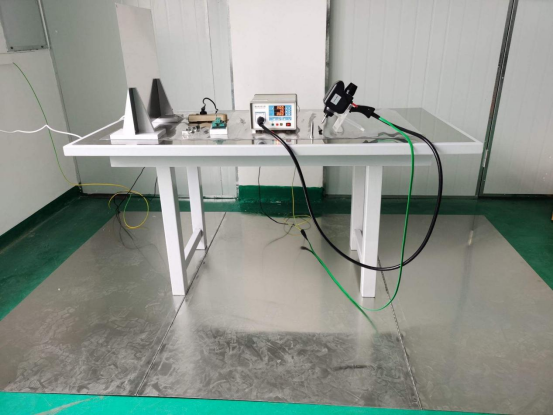
Electrostatic Discharge Immunity Test
Electrostatic discharge immunity test
Testing and measurment technitic discharge immunity test
1. Electrostatic discharge immunity test range:
This standard specifies the immunity requirements and test methods for electrical and electronic equipment subjected to electrostatic discharge directly from the operator and to adjacent objects. It also specifies the scope of test levels and test procedures under different environmental and installation conditions.
2. ESD immunity test reference standard:
GB/T Electromagnetic Compatibility Terminology
IEC 68-1:1998 Environmental Testing Part: General and Guidelines
3. ESD Immunity Test Overview
This standard deals with devices in electrostatic discharge environments and installation conditions. system. Subsystems and external devices. For example, low relative humidity, use low conductivity (rayon) carpets. Vinyl clothing, etc.
4. Electrostatic discharge immunity test definition:
4.1 Reduce degradation (of performance)
Undesirable deviation from the normal performance of the device or system
4.2 Electromagnetic compatibility (EMC) electromagnetic compatibility
The ability of a device or system to function properly in its electromagnetic environment without causing unacceptable electromagnetic disturbance to anything in that environment
4.3 Antistatic material antistatic discharge
When the same material or similar materials are rubbed or separated from each other, materials with a small amount of charge are generated
4.4 energy storage capacitor
The capacitor in the electrostatic discharge generator is used to represent the capacitance when the human body is charged to the test voltage value. It can be discrete components or distributed capacitance.
4.5 ESD electrostatic discharge
electrostatic discharge
4.6 EUT e under test
Test equipment
4.7 ground reference plane (GRP) ground reference plane
A conductive plane whose potential is used as a common reference potential
4.8 Coupling plate coupling plane
A sheet or plate of metal to be discharged to simulate electrostatic discharge to objects in the vicinity of the equipment under test
HCP: Horizontal Coupling Plate; VCP: Vertical Coupling Plate
4.9 Holding time
Before discharge, the time interval during which the test voltage drops by not more than 10% due to leakage
4.10 Electrostatic discharge electrostatic discharge ;ESD
Charge transfer caused by the proximity or direct contact of objects with different electrostatic potentials
4.11 Immunity (of disturbance)
The ability of a device or system to face electromagnetic disturbance without degrading its operational performance
4.12 Contact discharge method
A test method in which the electrodes of the test generator are kept in contact with the equipment under test and the discharge is excited by the discharge switch in the generator
4.13 Air discharge method
A test method in which the charging electrode of the test generator is brought close to the test equipment, and the test equipment is excited and discharged by a spark
4.14 Direct discharge direct application
Directly discharge the device under test
4.15 Indirect discharge indirect application
Discharge to the coupling plate near the device under test to simulate the discharge of personnel to objects near the device under test
5. Electrostatic discharge immunity test level:
Contact discharge is the preferred test method, and air discharge is used in situations where contact discharge cannot be used. The voltages for each test method are listed in Table 1. Due to the differences in test methods, the voltages shown for each method are different. The severity of the two test methods does not imply equal
1a Contact discharge 1b Air discharge
Grade Test voltage KV Grade Test voltage KV
1 2 1 2
2 4 2 4
3 6 3 8
4 8 4 15
* special * special
6. Electrostatic discharge immunity test generator:
The test generator mainly includes:
Charge resistance R; energy storage capacitor Cs; distributed capacitance Cd; discharge resistance Rd;
Voltage indicator; Discharge beginning; Replaceable discharge electrode tip; Discharge loop cable; Power supply unit
6.1 Characteristics of electrostatic discharge generators
Specification:
--------- Storage capacitor (Cs+Cd) 150pF±10%
---------Discharge resistance (Rd) 330ohm;±10%
--------Charging resistance (Rc) between 50Mohm; and 100Mohm;
--------Output voltage contact discharge 8KV; air discharge 15KV
-------Tolerable deviation of output voltage indication ±5%
--------Input voltage polarity positive and negative
--------holding time at least 5S
————Discharge, operation mode Single discharge
The cable of the discharge circuit in the test generator is generally 2m long, and its composition should make the generator meet the requirements of the waveform. It should have sufficient insulation to prevent electrostatic discharge current from flowing to personnel or conductive surfaces without passing through its ports.
6.2 Verification of Electrostatic Discharge Generator Characteristics